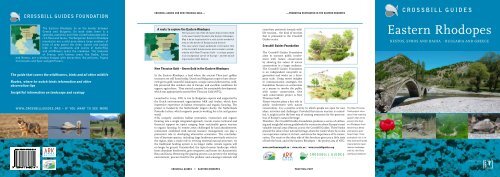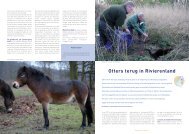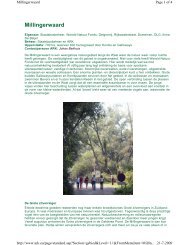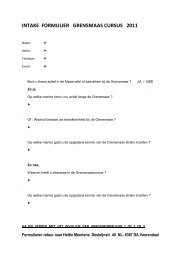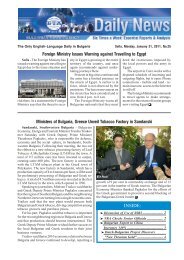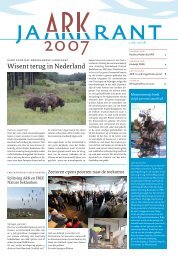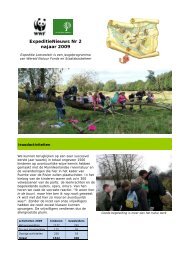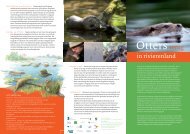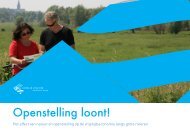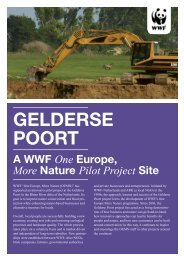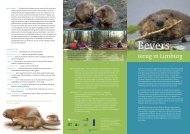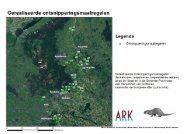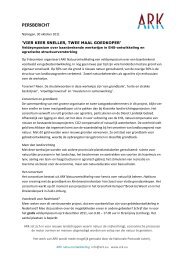Create successful ePaper yourself
Turn your PDF publications into a flip-book with our unique Google optimized e-Paper software.
crossbill guides foundation<br />
crossbill guides and new thracian gold...<br />
...promoting ecotourism in the eastern rhodopes<br />
c r o s s b i l l g u i d e s<br />
The <strong>Eastern</strong> <strong>Rhodopes</strong> lie on the border between<br />
EASTERN<br />
RHODOPES Greece and Bulgaria. On both sides there is a<br />
splendid, authentic and little visited landscape with a<br />
rich ora and fauna. The Bulgarian <strong>Eastern</strong> Rhodope<br />
mountains are a wild area where large numbers of<br />
region<br />
birds of pre patrol the skies, wolves and jackals<br />
hide in the woodlands and scores of butteries<br />
and wildowers grace the meadows. The lowlands<br />
of Greece, with famous areas like Dadia, Evros<br />
and Nestos, are a birding hotspot with attractions like pelicans, Pgm<br />
Cormorants and Spur-winged Plovers.<br />
The guide that covers the wildflowers, birds and all other wildlife<br />
Routes, where-to-watch-birds information and other<br />
observation tips<br />
Insightful information on landscape and ecology<br />
www.crossbillguides.org - if you want to see more<br />
GREECE<br />
A route to explore the <strong>Eastern</strong> <strong>Rhodopes</strong><br />
Here ou are: one of the 18 routes that are described<br />
in the new Crossbill Guide to the <strong>Eastern</strong> <strong>Rhodopes</strong>.<br />
BULGARIA Ma it be an inspiration for a visit to this wonderful<br />
area on the border of Bulgaria and Greece!<br />
EASTERN<br />
This new nature travel guidebook is the latest title<br />
RHODOPES<br />
in the Crossbill Guides series and is made in collaboration<br />
with New Thracian Gold – a unique project<br />
in an exceptional corner of Europe – and the Dutch<br />
organisation ARK Nature.<br />
New Thracian Gold – Green Gold in the <strong>Eastern</strong> <strong>Rhodopes</strong><br />
In the <strong>Eastern</strong> <strong>Rhodopes</strong>, a land where the ancient Thracians’ golden<br />
treasures are still found today, Dutch and Bulgarian experts have discovered<br />
green gold: beautiful landscapes, unique natural phenomena, wildlife<br />
preserved like nowhere else in Europe, and excellent conditions for<br />
organic agriculture. They started a project for sustainable development,<br />
which was appropriately named New Thracian Gold (NTG).<br />
Launched in 2009, NTG is run by Bulgarian experts and supported by<br />
the Dutch environmental organisations ARK and Avalon, which have<br />
impressive experience in habitat restoration and organic farming. The<br />
project is funded by the Netherlands’ largest charity, the Netherlands<br />
Postcode Lottery, which supports projects working for a fair and greener<br />
world.<br />
NTG uniquely combines habitat restoration, ecotourism and organic<br />
farming into a single integrated approach. Locals receive technical and<br />
financial support on topics ranging from sustainable green tourism<br />
to organic farming. In remote areas challenged by land abandonment,<br />
ecotourism combined with natural resource management can play a<br />
prominent role in developing alternative economies. The reintroduction<br />
of keystone species, including large herbivores previously extinct in<br />
the region, plays a major role in reviving essential natural processes. As<br />
the traditional herding system is no longer viable, remote regions will<br />
no longer be grazed. Uncontrolled, the typical mosaic landscape, which<br />
hosts abundant biodiversity, gets overgrown and looses its characteristic<br />
flora and fauna. Restoring the grazing process can preserve the existing<br />
environment, procure food for the predator and scavenger animals and<br />
contribute positively towards wildlife<br />
tourism… the kind of tourism<br />
that is promoted in the Crossbill<br />
Guides series.<br />
Crossbill Guides oundation<br />
The Crossbill Guides Foundation<br />
aims to increase public involvement<br />
with nature conservation<br />
by showing the values of nature<br />
conservation to a larger audience.<br />
The Crossbill Guides Foundation<br />
is an independent non-profit organisation<br />
and works on a European<br />
scale. Using recent insights<br />
in communication strategies, the<br />
foundation focuses on ecotourism<br />
as a means to involve the public<br />
with nature conservation. One<br />
such conservation project is New<br />
Thracian Gold.<br />
Nature tourism plays a key role in<br />
public involvement with nature<br />
conservation. It is a positive activity in which people are open for new<br />
ideas, activities and challenges. Provided that nature tourism is controlled,<br />
it might just be the best way of creating awareness for the preservation<br />
of Europe’s natural heritage.<br />
Therefore, the Crossbill Guides Foundation produces a series of enthusing<br />
and insightful nature guidebooks for ecotourists about Europe’s most<br />
valuable natural areas (Natura 2000): the Crossbill Guides. These books<br />
present the value of our natural heritage, show the visitor where he or she<br />
can experience nature at its best, and stress the importance of its conservation.<br />
The route on the other side of this brochure gives you a little taste<br />
of both the book, and of the <strong>Eastern</strong> <strong>Rhodopes</strong> – the project area of NTG.<br />
www.newthraciangold.eu / www.ark.eu / www.crossbillguides.org<br />
c r o s s b i l l g u i d e s<br />
IF y O W A N T T O S E E M O R E<br />
The New Thracian<br />
Gold project introduces<br />
free-roaming<br />
grazers that are to<br />
prevent the <strong>Eastern</strong><br />
<strong>Rhodopes</strong> from<br />
becoming a dense<br />
and species-poor<br />
forest (top). Their<br />
ecological role is to<br />
help maintaining the<br />
characteristic open<br />
mosaic landscape<br />
with its rich ora<br />
and fauna (bottom).<br />
<strong>Eastern</strong> <strong>Rhodopes</strong><br />
NESTOS, EVROS AND DADIA - BULGARIA AND GREECE<br />
crossbill guides<br />
• eastern rhodopes<br />
practical part
oute 5: along the arda river<br />
route 5: along the arda river<br />
route 5: along the arda river<br />
route 5: along the arda river<br />
1<br />
Route 5: Along the Arda River<br />
6 R – DA<br />
50 <br />
The famous vulture cliffs of Madzharovo<br />
Scenic route through mountains and with<br />
a rich birdlife on Ardas north bank<br />
abitats: river, scrubland, ston grasslands, cliffs, oak forest, elds, marshland<br />
elected species: Pink Butter Orchid, Jackal, Otter, White-tailed Eagle,<br />
Black Stork, Griffon Vulture, Peregrine, Golden Eagle, Western Rock Nuthatch,<br />
Blue Rock Thrush, Rock Bunting, Sand Boa, Small Bath White, Russian<br />
Heath, Sand Grizzled Skipper, Freer’s Purple Emperor<br />
This scenic route takes you along the north bank of the Arda River.<br />
Some of the more famous sites of the <strong>Eastern</strong> <strong>Rhodopes</strong> are on this<br />
route, such as the breeding colony of the Griffon Vultures and the picturesque<br />
meander of the Arda River. But the route takes you beyond<br />
these places and into a broad valley with, for the region, atypical marshlands.<br />
This route is primarily of interest for its birdlife, but reptiles,<br />
butterflies and dragonflies enthusiasts will not be disappointed.<br />
Departure point Vulture centre, Madzharovo. The centre is situated<br />
next to the bridge over the Arda River.<br />
Arda<br />
GORNO POLE<br />
MADZHAROVO<br />
2<br />
1<br />
cliffs<br />
3<br />
vulture<br />
centre<br />
gazebo<br />
5<br />
4<br />
0<br />
7<br />
BORISLAVTSI<br />
6<br />
Ivaylovgrad<br />
reservoir<br />
2 KM<br />
1<br />
The vulture centre (actually the BSPB nature information centre;<br />
which also has a small restaurant) is a good starting point. Local English-speaking<br />
ecologists provide up to date information on the area and its<br />
species. The terrace lights in front of the centre attract many moth species<br />
like Cream-spot Tiger, Eyed and Small Elephant Hawk-moth and the impressive<br />
Giant Peacock Moth, which often rest on the vegetation near the<br />
lamps. From the vulture centre, walk to the bridge where, to the left, a trail<br />
leads down to the river. This is worth exploring, especially for the endemic<br />
Small Bath White, that flies near dried up riverbeds.<br />
Cross the bridge and turn right to Borislavtsi.<br />
2<br />
After 800 metres the tarmac<br />
road crosses a dirt road. Park<br />
on the left and continue on foot. A<br />
small stream has carved a steep little<br />
valley through the rocks. The<br />
open patch of dry flowery grassland<br />
is a butterfly hotspot attracting<br />
species like Krueper’s Small<br />
White, Tree Grayling, <strong>Eastern</strong> Baton<br />
Blue and Southern Festoon.<br />
The stream itself supports Yellowbellied<br />
Toad, Southern Crested<br />
Newt and Fire Salamander. Dice<br />
Snake and Grass Snake are frequent<br />
here as well. Don’t forget to<br />
look up every once in a while. The<br />
vulture cliffs are nearby, so Griffon<br />
and Egyptian Vultures drift<br />
over frequently. Keep an eye out for<br />
Sombre Tit, <strong>Eastern</strong> Orphean and<br />
Barred Warblers here and at the<br />
stops ahead.<br />
On the other side of the main road,<br />
the dirt track leads down to the<br />
Arda river, where there is a big colony<br />
of Bee-eaters. Look for Grecian<br />
Copper and Lattice Brown in the<br />
open patches between the trees.<br />
2<br />
The Arda river cuts<br />
through the volcanic<br />
rock of Madzharovo.<br />
This is perhaps the<br />
most famous place of<br />
the <strong>Eastern</strong> <strong>Rhodopes</strong>:<br />
the Arda bend with the<br />
vulture cliffs.<br />
3 Continue by car in the direction of Borislavtsi and after 1 km you find a<br />
picnic table on the right side of the road.<br />
grasslands that fringe the northern<br />
reservoir for Squacco Heron,<br />
Little Egret, Little Grebe, Cormorants<br />
and swans. The vegetation<br />
3<br />
This is a spectacular place, squeezed between the cliffs and the<br />
river. Check the cliffs where the Griffon Vultures, in one of the few<br />
near the stream is worth looking<br />
colonies in the region, breed. Birds of prey here frequently include Egyptian<br />
Vulture, Peregrine and Golden and Booted Eagles. Other birds to<br />
look for are Black Stork, Chukar (rare), Black-eared Wheatear, Blue Rock<br />
Thrush, Western Rock Nuthatch and Rock Bunting. On the other side,<br />
for dragonflies and damselflies<br />
as Broad Darter, Common Winter<br />
Damsel, Large Red-eye and<br />
White-tailed Skimmer.<br />
you have a good view over the river. Apart from the splendid scenery you<br />
might be lucky to spot an Otter in dusk or dawn.<br />
Continue over the dam and park<br />
on the left just before the next<br />
bridge. A 1 1 / 2<br />
km walk along the<br />
stream leads you to a small lake.<br />
Continue and take the first tarmac road to the right, which brings you<br />
down to the Arda.<br />
4<br />
At the river, leave your car at the information panel and continue on<br />
foot. Keep an eye out for fishing Black Stork on the pebble banks,<br />
and for Little Ringed Plover, which breeds here. Banded Demoiselles and<br />
Common Clubtail are frequent dragonflies in springtime. An early morning<br />
visit, in combination with a healthy dose of luck, may produce an<br />
encounter with the highly illusive Sand Boa, an Otter or a Jackal, all of<br />
which are seen here on a regular basis. Don’t forget to check the cliffs and<br />
the sky, for similar birds may appear here as on the previous site.<br />
Retrace your steps to the main road and turn right. After about 5 km you<br />
see a wooden gazebo on your left. Park here.<br />
5<br />
The reservoir in the valley is part of the Arda River, which is dammed<br />
close to Ivaylovgrad. In the area a pair of White-tailed Eagle nests –<br />
one of the rarest breeding raptors of the region. They can sometimes be<br />
seen hunting over the area although your chances are better of spotting<br />
a Black Kite, another raptor that is not common in the region. Explore<br />
the Christ’s-thorn scrubland behind the gazebo which is a good site for<br />
Olive-tree Warbler, Woodchat Shrike and Subalpine Warbler. Among the<br />
butterflies, Little Tiger Blue and Sandy Grizzled Skipper often rest on<br />
stones in the grassland.<br />
6<br />
Continue to the village of Borislavtsi and be careful as the road<br />
is in bad condition. Drive through the village (Spanish Sparrows<br />
breed in the Stork’s nests) and stop at the first bridge. Scan the marshy<br />
7<br />
The fields on the left have Black-headed Bunting and Black-headed<br />
Wagtail. On your right, you overlook the bushy vegetation lining<br />
the stream. This is a good place for smaller songbirds and woodpeckers<br />
(Green and Syrian). The Blackthorns attract Brown Hairstreaks. The<br />
small lake at the end of the trail is fringed by marshland and reed beds.<br />
This makes this site an excellent one for Marsh Harrier, Kingfisher, Great<br />
Reed Warbler and Moorhen. Explore the grassy terrain near the lake for<br />
Pink Butterfly and Lady Orchids. Silver-studded Blue and Marsh Fritillary<br />
are so common in season that they cannot be overlooked.<br />
Return the way you came.<br />
4<br />
Two specialists of cliffs<br />
that ou are likel to<br />
see on this route: the<br />
Griffon Vulture (top)<br />
and the Blue Rock<br />
Thrush (bottom).<br />
crossbill guides<br />
• eastern rhodopes<br />
practical part<br />
crossbill guides<br />
• eastern rhodopes<br />
practical part


